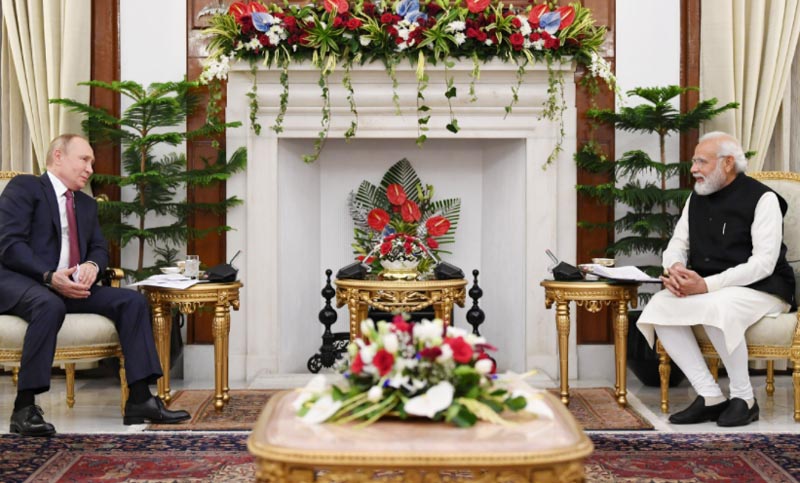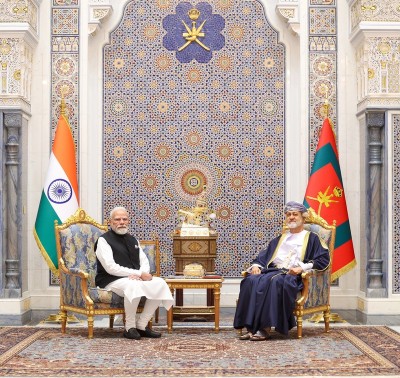 Vladimir Putin-Narendra Modi
Vladimir Putin-Narendra Modi
Putin’s visit: Two signals and a warning
Despite the solidarity and mutual respect on display at the summit, there are clear differences between Moscow and New Delhi on fundamental issues which cannot be wished away. Ramananda Sengupta writes
Russian President Vladimir Putin’s brief visit to India December 6 for the annual India-Russia summit with Prime Minister Narendra Modi was not just to showcase the strength and importance of the long and friendly relationship between the two nations, which stretches back to the days of the former Soviet Union and the Cold War era.
The summit, which was preceded by the first 2+2 meeting between the defence and foreign ministers of the two nations, was also a loud, clear signal to the rest of the world that:
a) neither country will bow to diktats or threats of any other power, and
b) the bilateral relationship is judged on its own merits, and not on the basis of ties with other major powers.
Despite the threat of possible sanctions by United States of America, which also happens to be a key strategic partner for New Delhi, India has started taking delivery of the Russian S-400 Triumf, said to be among the most advanced air defense systems available today.
The decision, clearly conveyed to the Americans, was not just based on the fact that Russian weapons –ranging from small arms to sophisticated fighter aircraft, warships, tanks, submarines and of course platforms like the S-400 -- form the mainstay of the Indian armed forces.
INS Vikramaditya, India’s sole operational aircraft carrier, is a radically refurbished Soviet Kiev Class carrier, originally known as the Admiral Gorshkov.The former Soviet Union/Russia leased two nuclear powered submarines -- a Charlie class from 1988 to 1991, and an Akula class from 2012 to June 2021 -- to train Indian sailors. Both were christened INS Chakra by the Indian Navy, and a third is expected in 2025. Hindustan Aeronautics Limited makes the Sukhoi MK I under license from Russia, and the Brahmos, a medium range supersonic cruise missile which can be launched from land, air, sea, and submarines, is a joint venture between the two nations.
If Washington –or Beijing-- believed that the threat of unilateral sanctions or the offer of high-end American weapons would erode the strategic relations between New Delhi and Moscow, the 10-year defence partnership pact signed between the two nations during Putin’s visit was the equivalent of a rude middle finger.
.jpg)
Similarly, it would be truly naïve to believe that Russia’s growing strategic relationship with China --and to an extent Pakistan-- was purely in responseto India’s ‘tilt’ towards the United States, which sees both China and Russia as major threats, and has publicly backed India’s position on the border conflict with Beijing.
China, whose trade with Russia exceeded USD 100 billion in 2020 and wants to double that by 2024, had earlier voiced its unease over the proposed sale of the S-400 and other high-end systems to India. In comparison, Russia-India bilateral trade peaked at 11.16 billion in 2019, and dropped to 9.3 billion in 2020. The two countries have set an ambitious target of USD 30 billion by 2025.
Yet within weeks of the savage hand-to-hand clash between Indian and Chinese troops in the Galwan Valleyon June 15, 2020,in which 20 Indian soldiers and an unspecified number of PLA troopers were killed, Indian Defence Minister Rajnath Singh and Defence Secretary Ajay Kumar arrived in Moscow with a long wish list.
Apart from the urgent supply of spare parts, ammunition and missiles for the Russian Sukhois, T-90 tanks and Kilo-class submarines in use by the Indian military, they wanted 21 new MiG-29 multi-role fighters, a fairly large number of the Igla-S Man-portable air defense systems and other assorted weapons and spares as soon as possible. India also wants the brand new Sprut-SDM1 light tanks, which can be airlifted and para-dropped with crew inside, to counter the new Type 15 lightweight tanks which China has deployed along the mountainous disputed border.
According to defence ministry sources, not only were the high priority spares delivered “almost immediately,” there was not a single item on that list that the Russians refused. And a Russian diplomat remarked that though Beijing might have expressed its concerns privately, “it knows better than to make it an official issue,” because they are well aware that Moscow resents any interference in such things and would “definitely push back.”
Similarly, despite the fact that the PLA, with a defence budget estimated at over USD 261 billion (compared to India’s $ 71 billion) clearly has a far larger military inventory, New Delhibristles at any suggestions that it is being “used” as a counterweight against China by the United States. “We are a sovereign nation, and far too big to be used by anyone,” is the standard response, followed by how the government would not allow anyone to dilute India’s “strategic autonomy” or “our constant quest for a multilateral world order.”
And to underline this, it is often pointed out that India is a key member of several “multilateral and plurilateral” organisations and groupings like BRICS, an acronym for the five major emerging economies -- Brazil, Russia, India, China, and South Africa, and the Shanghai Cooperation Organization (SCO), also known as the Shanghai Pact, a Moscow-Beijing led Eurasian political, economic and security alliance, to name just two, apart from strong strategic partnerships with over two dozen nations.
But despite the solidarity and mutual respect on display at the summit, it is important to remember that there are clear differences between Moscow and New Delhi on various fundamental issues which cannot be wished away, and must be addressed with great understanding and sensitivity. In a rapidly changing world, it would be easy, but extremely dangerous to take this relationship for granted instead of constantly nurturing it. Complacency, or any violation, real or perceived, of each other’s permanent interests could kill it overnight.
(Ramananda Sengupta is a foreign and strategic affairs analyst and a consulting editor with IBNS. He can be reached at ramananda.sengupta@gmail.com)
Support Our Journalism
We cannot do without you.. your contribution supports unbiased journalism
IBNS is not driven by any ism- not wokeism, not racism, not skewed secularism, not hyper right-wing or left liberal ideals, nor by any hardline religious beliefs or hyper nationalism. We want to serve you good old objective news, as they are. We do not judge or preach. We let people decide for themselves. We only try to present factual and well-sourced news.






